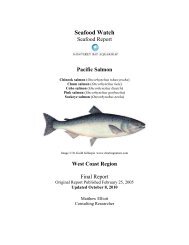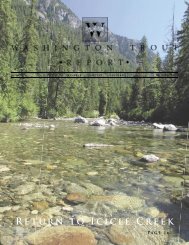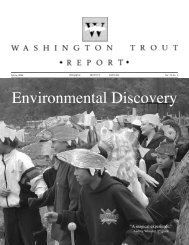Whidbey Island Near Shore Research Project
Washington Trout Report - Wild Fish Conservancy
Washington Trout Report - Wild Fish Conservancy
- No tags were found...
Create successful ePaper yourself
Turn your PDF publications into a flip-book with our unique Google optimized e-Paper software.
Continued from page 10<br />
and analyzed in the BA. Several lines of evidence suggest<br />
the proposal could even risk the extirpation of some<br />
individual populations within the LCR steelhead ESU.<br />
The request to raise allowable impacts on LCR<br />
steelhead is driven by the needs of the fishery, but the<br />
proposal fails to appropriately balance the interests of<br />
commercial fishing against the recovery needs of listed<br />
Lower Columbia River steelhead. For the last several<br />
years, WDFW and ODFW have attempted to prosecute a<br />
“demonstration” commercial fishery for hatchery spring<br />
chinook in the lower Columbia River utilizing so-called<br />
“selective” fishery-gear, tangle-nets and recovery boxes.<br />
The smaller-mesh tangle-nets and the recovery boxes<br />
(aerated tanks of water) are intended to reduce mortality<br />
and allow the release of non-target fish, in this case<br />
Threatened wild spring chinook and Threatened LCR<br />
steelhead. Unfortunately the “tangle-net” fishery has so far<br />
not been able to provide a productive fishery for hatchery<br />
chinook without exceeding the existing impact limits on<br />
either wild chinook or LCR steelhead. Unable to hold the<br />
fishery within established guidelines, managers simply<br />
requested that the guidelines be relaxed.<br />
Working with a coalition of advocates including<br />
the Wild Steelhead Coalition, Oregon Trout, the Native<br />
Fish Society, and Trout Unlimited, WT focused efforts on<br />
convincing the Oregon and Washington Fish and Wildlife<br />
Commissions to conduct the fishery under the 2% impactlimit,<br />
NOAA’s decision notwithstanding. The Washington<br />
Commission decided to essentially split the baby and<br />
approved a 4% allowable impact. But at the eleventh hour,<br />
the Oregon Commission, responding in large part to public<br />
input, stood up for the fish and rejected the impact increase.<br />
The 2005 fishery was conducted under the 2% impact limit<br />
for LCR steelhead.<br />
Preliminary data from the fishery indicates that<br />
impacts to wild steelhead were held below the 2% limit.<br />
However, the fishery was constrained by impacts to other<br />
wild stocks, and lower than expected returns of some<br />
chinook stocks. Ironically, wild steelhead returns appear<br />
to be lower than preseason projections by almost half. Had<br />
the fishery been conducted under the relaxed guidelines,<br />
impacts on steelhead might have been significantly higher<br />
than predicted by Compact managers, which creates<br />
serious questions about the two departments’ ability to<br />
manage impacts in these types of mixed-stock fisheries.<br />
WT fully supports the development of selective<br />
fishery techniques to effectively allow the sustainable<br />
harvest of relatively healthy salmon stocks while<br />
minimizing impacts to listed and other at-risk populations.<br />
However, the data from the tangle-net fisheries dating back<br />
to 2002 strongly reinforce the suggestion that tangle-nets<br />
used with recovery boxes are not effective non-lethal<br />
fishing gear, and may not be appropriate for conducting<br />
truly selective fisheries. Increasing risks on listed<br />
steelhead in order to accommodate this fishery is simply<br />
inappropriate. WT will continue to press NOAA Fisheries<br />
and the Columbia River Compact to reject this unsound<br />
proposal.<br />
NOAA Fisheries Proposes Inappropriate<br />
Hatchery Policy<br />
In May 2004, The Bush Administration proposed<br />
a new policy regarding the treatment of hatchery and wild<br />
salmon and steelhead in federal ESA-listing decisions.<br />
The administration intends to count hatchery salmon and<br />
steelhead in determining the health of wild populations,<br />
something most scientists say likely will impede longterm<br />
recovery. The policy faces broad opposition<br />
throughout the region from scientists, wild-fish advocates,<br />
environmentalists, community leaders, regional policy<br />
makers, and members of Congress.<br />
Working with a broad coalition of environmental<br />
organizations and wild-fish advocates, Washington Trout<br />
has contributed to developing a coordinated response to<br />
the proposal. Efforts before the May announcement may<br />
have influenced NOAA to retreat from some of the most<br />
potentially damaging immediate impacts of the policy,<br />
leaving 25 of the 26 currently listed populations of salmon<br />
and steelhead at least temporarily protected under the new<br />
policy. WT participated in public hearings, media and<br />
public outreach, and in drafting comments on the proposed<br />
policy, submitted in November 2004.<br />
While temporarily retaining federal protections<br />
for wild fish stocks, the policy will still use hatchery fish to<br />
determine the health of individual wild stocks, and could<br />
still result in the early and inappropriate removal of ESA<br />
protections from declining wild salmon populations and<br />
their habitats. A wide range of respected fisheries scientists<br />
and ecologists maintain that the policy would jeopardize<br />
the recovery of listed wild populations.<br />
NOAA’s own “Recovery Science Review Panel”<br />
has issued two reports highly critical of the proposal.<br />
Representatives from the RSRP noted in an article that<br />
appeared in the prestigious journal Science, “much<br />
evidence exists that hatcheries cannot maintain wild<br />
salmon populations indefinitely,” and warned that while<br />
it is contrary to the science, including hatchery fish in<br />
listing decisions “opens the legal door to the possibility of<br />
maintaining a stock solely through hatcheries.” (Emphasis<br />
added.)<br />
Also reacting loudly to speculation about the<br />
legal implications of the policy have been industry and<br />
development groups, who favor the removal of ESA<br />
protections for both hatchery and wild fish, and the reduced<br />
restrictions on logging, agriculture, and other forms of<br />
development that would result. It is clear they believe this<br />
28






